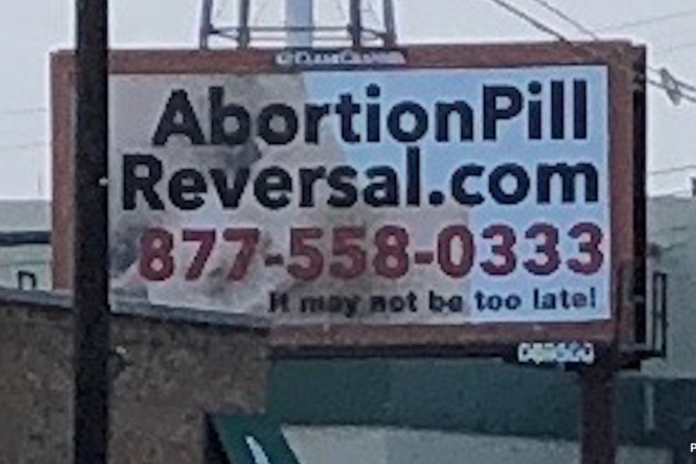Two pro-life billboards were taken down in St. Paul, after the billboard stand owner—who remains unknown—threatened the billboard company, Clear Channel, that the billboard stand owner would not renew the lease with Clear Channel unless the billboards were taken down.
One billboard gave the website and number for Abortion Pill Reversal (877-558-0333), and another the phone number and website for women facing an unplanned pregnancy, OptionLine.org (800-712-4357). Both advertisements were taken out by the pro-life group, Pro-Life Action Ministries (PLAM).
The billboards were strategically placed by PLAM right next to Planned Parenthood’s St. Paul mega clinic, which performs well over 6,000 abortions per year. Around 40 percent of these abortions are chemically-induced, via the abortion pill regimen.
City Pages, a far-left outlet based in Minneapolis, ran a hit-piece on the billboards, which may have led to their removal. The City Pages piece repeated false information about abortion pill reversal, characterizing the abortion pill regimen as completely safe, while claiming pill reversal is incredibly dangerous. Actually, reversal is much less-dangerous than liberal media have suggested, and the “normal” abortion-pill regimen endangers women. And while no women have died from pill-reversal, 24 women have died from the abortion pill regimen, while thousands have been injured.
It’s quite possible that the pro-life billboards were beginning to bug Planned Parenthood financially. One wonders how much the local Planned Parenthood affiliate, Planned Parenthood North Central States, coordinates with City Pages.
Planned Parenthood can’t stand the heat
Planned Parenthood operates under a franchise-franchisee model. The national organization handles marketing and broad political activities, while local franchisees, or affiliates—including Planned Parenthood of North Central States (PPNCS)—conduct day-to-day “operations.”
These local affiliates are extremely sensitive to basic economics, and are cost-sensitive. They are financially independent from the parent, and must break even on their own. If they do more than break even, they get to pay the staff more and offer better benefits.
They also depend heavily on abortion. Assuming abortion only costs $500, and the margin (revenue after cost) for abortion is 20 percent—an extremely conservative estimate—the percent of affiliate revenue after expenses that comes from abortion is 35 percent. If the margin on abortion is 40 percent, which is certainly within the realm of possibility, affiliate revenue after expenses from abortion is 75 percent (click here for an explanation of how this number, which certainly wasn’t published by Planned Parenthood, was arrived at).
The affiliate revenue after expenses that comes from abortion is probably on the high end both because clinics face little competition, largely due to regulatory pressures, and because while chemical abortion costs around $500-600, surgical abortions—around 60 percent of abortions—cost around $1,000 in the first trimester alone.
Not only do clinics depend heavily on abortion for profit, the other side of the profit equation has led affiliates like PPNCS to opt for megaclinics, like the one in St. Paul, in order to achieve better economies of scale and cut costs further. According to an insider, affiliates have abortion targets, budgets, and aim to have a woman on and off the table in around 5 minutes in order to maximize clinic “productivity.”
Because of this crazy, laser-focus on abortion, Planned Parenthood franchisees do a bad job at what they claim in advertising they do—provide birth control. And because women who frequent these clinics don’t have many choices, Planned Parenthood can continue to do a substandard job at providing birth control.
In fact, Planned Parenthood’s target customer, young unmarried women who are disproportionately black American women, may help explain the high abortion rate among black Americans—which should be seen as a national crisis. Critics say this is because of a lack of access to birth control, but Planned Parenthood is the organization supposedly providing this demographic with birth control access.
In other words, the City Pages hit, and Planned Parenthood not liking the billboards, is not just about a disagreement over a controversial issue. It’s about money.
What can policymakers do?
Time to crack down on the perverse profit motive. For starters, policymakers can continue to pass laws that increase the costs to affiliates. One example is a law requiring ultrasound use during the abortion procedure. This would hit franchisees’ bottom line, and make the procedure safer for women. States should also require mandatory reporting at emergency rooms, to track how often a woman is admitted with leftover remnants of the fetus in her womb, often due to an abortion performed by a hurried doctor (with a profit motive). Clinics that send women to the E.R. should face stiff penalties, and ultimately closure.
Another example is laws that require increased oversight and warnings about chemical abortions, which Planned Parenthood is attempting to at least partially shift toward, probably because of the higher margins involved. Another solution still is more birth control providers to poor women who don’t offer or refer abortions, and thus don’t have an extreme financial incentive to guide customers toward abortion.
And finally, too many abortions in the U.S. are subsidized by the taxpayer. That’s because, while federal Medicaid doesn’t broadly fund abortion, 16 states direct Medicaid to pay for all or most abortions—9 of these states do so because of a court order. In Minnesota, taxpayers fund over 4,000 abortions per year. The Trump administration laudably ended Planned Parenthood’s access to Title X, but the big money comes from Medicaid. To the extent possible, the administration should look to crack down on federal Medicaid funding to abortion providers, and foster greater access to birth control providers who don’t provide birth control.











